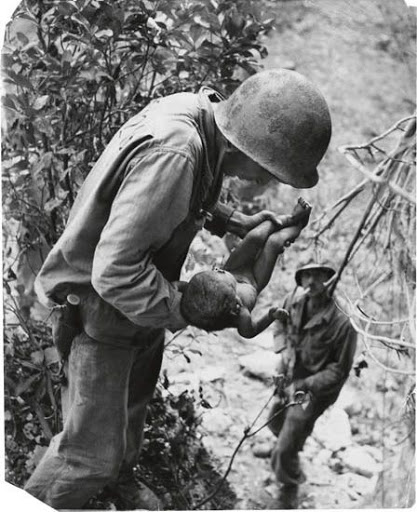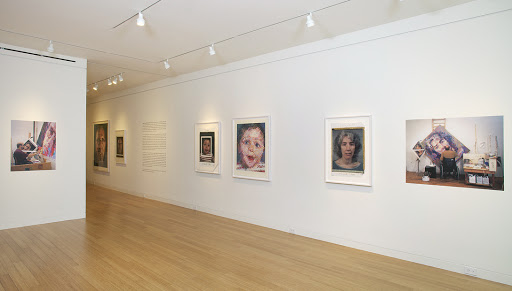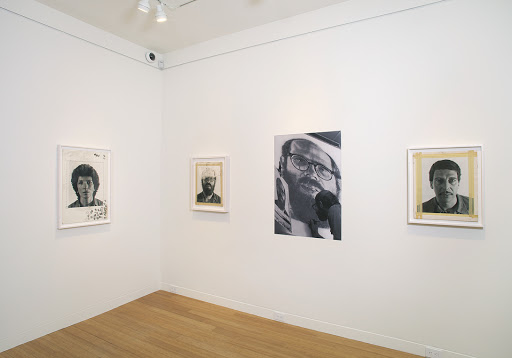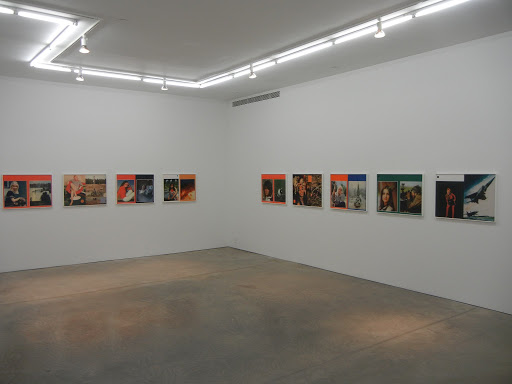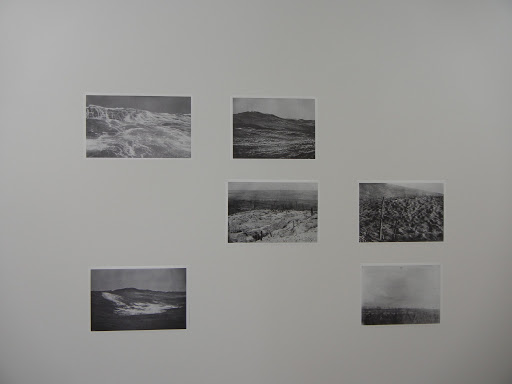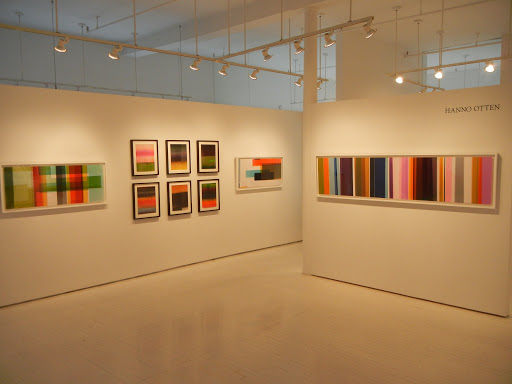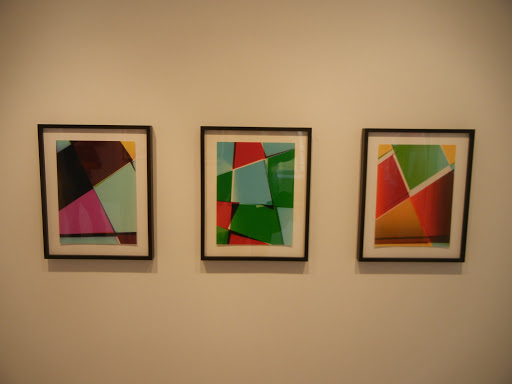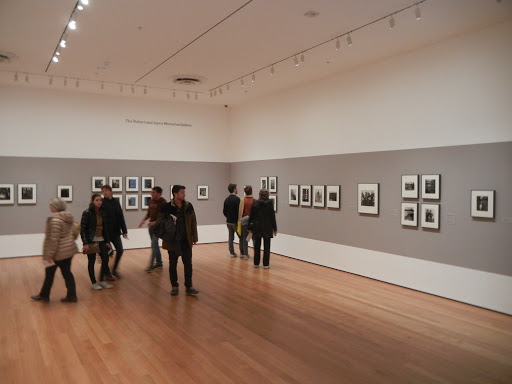 JTF (just the facts): A total of 156 black and white photographs, variously displayed in white, grey, and black frames with mats, and hung against white walls with grey horizontal stripes in three interconnected gallery spaces on the third floor of the museum. The works on view are generally vintage prints, taken between 1929 and 1978. The exhibit was curated by Sarah Hermanson Meister with assistance from Drew Sawyer. A catalog was published by MoMA in conjunction with the exhibition (here). (Installation shots at right.)
JTF (just the facts): A total of 156 black and white photographs, variously displayed in white, grey, and black frames with mats, and hung against white walls with grey horizontal stripes in three interconnected gallery spaces on the third floor of the museum. The works on view are generally vintage prints, taken between 1929 and 1978. The exhibit was curated by Sarah Hermanson Meister with assistance from Drew Sawyer. A catalog was published by MoMA in conjunction with the exhibition (here). (Installation shots at right.)
The show is divided into six named sections, with a short introductory prelude. For each section, the number of prints on view has been tallied, along with relevant dates for the images. Books and magazine spreads shown in cases have also been listed.
(Prelude)
4 gelatin silver prints, 1929, 1930, 1933
1 case containing 9 album pages, 1920s-1930s
 London in the Thirties
London in the Thirties
36 gelatin silver prints, 1932-1939
Northern England
12 gelatin silver prints, 1937
World War II
22 gelatin silver prints, 1939-1945
7 cases containing 11 magazine spreads, 1939-1945
Portraits
25 gelatin silver prints, 1946-1978
Landscapes
13 gelatin silver prints, 1945-1963
1 case containing 8 magazine spreads and 2 books, 1942-1961
Nudes
44 gelatin silver prints, 1945-1959
 Comments/Context: When a photographer starts to have labels like “the most important British photographer of the 20th century” affixed to his name, it might be safe to assume that the story of his art and life would be well understood, that it could be summed up in a pithy sentence or two designed for easy recitation. But of all our modern masters, Bill Brandt remains the most stubbornly elusive. Whether we are looking at the trajectory of his life or the evolution of his photography, the facts just don’t seem to fall neatly into place. This robust and scholarly retrospective does an admirable job of trying to make sense of it all, diving into the forgotten details and uncovering important missing links, but in the end, Brandt resists easy interpretation, remaining ever evasive and ambiguous, an artistic shape shifter quietly slipping through our fingers.
Comments/Context: When a photographer starts to have labels like “the most important British photographer of the 20th century” affixed to his name, it might be safe to assume that the story of his art and life would be well understood, that it could be summed up in a pithy sentence or two designed for easy recitation. But of all our modern masters, Bill Brandt remains the most stubbornly elusive. Whether we are looking at the trajectory of his life or the evolution of his photography, the facts just don’t seem to fall neatly into place. This robust and scholarly retrospective does an admirable job of trying to make sense of it all, diving into the forgotten details and uncovering important missing links, but in the end, Brandt resists easy interpretation, remaining ever evasive and ambiguous, an artistic shape shifter quietly slipping through our fingers.
While most exhibition introductions feel like throwaways, this one sets the stage particularly adeptly. Four early prints from the late 1920s and early 1930s show Brandt searching for his own vision, trying on the styles and subject matter of Kertesz, Brassai, Man Ray, and Abbott, with a little rich Eastern European darkness here and a little distorted Surreal camera angle there. The albums of early snapshots displayed underneath find Brandt examining British life with an unexpected mix of outsider perspective (he was German by birth after all) and upper class insider access. Together, this smart prelude conceptually brings together the many influences of his early years and loosely predicts some of what would come later.
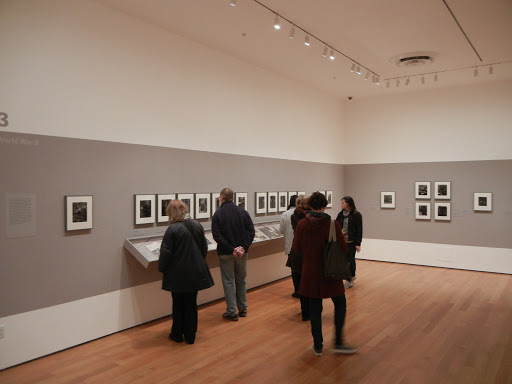 The first major section of the exhibit combines images from Brandt’s first real claim to fame, his 1936 book The English at Home, and its speedy follow up, A Night in London, from 1938. The pictures capture a broad spectrum of British life, from parlourmaids and bar customers to top-hatted aristocrats and grimy miners, and from street kids and theatregoers to intellectuals and illicit lovers. But there is much more going on in these pictures than straight documentation; each photograph has an undercurrent of almost anthropological curiosity, an eye for the dark oddness of the everyday. Fancy men in morning suits and ladies in hats cluster atop a carriage for a better view of the hunt, while blank-eyed children stand frozen in a forest of weary birthday party balloons. A fish market porter balances a tuna on his head, while a young girl prances in the street saucily showing off a bit of leg. A raceday barker stands in a pose of crucifixion, while a policeman guards a gloomy brick alley. Back and forth, Brandt mixes high and low with unexpected deftness, highlighting the muted eccentricities of both with equal success. In his hands, even little details, like a display of opera hats and an elegant white egret in a grassy manicured garden, seem at once entirely ordinary and surprisingly weird.
The first major section of the exhibit combines images from Brandt’s first real claim to fame, his 1936 book The English at Home, and its speedy follow up, A Night in London, from 1938. The pictures capture a broad spectrum of British life, from parlourmaids and bar customers to top-hatted aristocrats and grimy miners, and from street kids and theatregoers to intellectuals and illicit lovers. But there is much more going on in these pictures than straight documentation; each photograph has an undercurrent of almost anthropological curiosity, an eye for the dark oddness of the everyday. Fancy men in morning suits and ladies in hats cluster atop a carriage for a better view of the hunt, while blank-eyed children stand frozen in a forest of weary birthday party balloons. A fish market porter balances a tuna on his head, while a young girl prances in the street saucily showing off a bit of leg. A raceday barker stands in a pose of crucifixion, while a policeman guards a gloomy brick alley. Back and forth, Brandt mixes high and low with unexpected deftness, highlighting the muted eccentricities of both with equal success. In his hands, even little details, like a display of opera hats and an elegant white egret in a grassy manicured garden, seem at once entirely ordinary and surprisingly weird.
Many of Brandt’s 1930s images are steeped in deep darkness, full of shadows and hollows and printed with an eye for middle range greys. Brandt’s photographs of the depressed coal mining and industrial towns of Northern England follow in this stylistic path, capturing sooty smokestacks, rainswept cobblestones, and dirty children with heavy visual weight. His images of the London blackout and the bombed out buildings of World War II are equally pensive and moody. Crowds sleep on top of each other in improvised air-raid shelters in tube stations, while moonlight darkly illuminates rubble piles in front of the looming dome of St. Paul’s. As the years passed, it was almost as if the novelty of being British had started to wear off, and a more morose tone took its place.
 I think the biggest revelation this exhibit has to offer is the examination of the middle years of Brandt’s career in the context of magazines. The many spreads from Lilliput, Picture Post and others show Brandt on assignment, his images reproduced in thematic groups in small hand held (mostly vertical) formats. For me, this background material helped to fill in an underlying logic for how and why Brandt transitioned from his early work to the landscapes, portraits, and other subjects that seem less obviously connected. His 1940s landscapes have a rough, elemental wildness, from sheep grazing near the stones of Avebury to the dramatic wind-blown grasses of Top Withens. Forests and rolling hills are reduced to expanses of darkness, while paths and rivers burn with bright whiteness against the encroaching land. Brandt’s commissioned portraits from the same period (and later) settle into a similarly serious mood: Norman Douglas glowers from his writing desk and Francis Bacon looks lost in a brooding reverie while walking along a grey park path. The shifting moods of these images point to a increasingly psychological approach to photography, with Brandt layering swaths of dark, personal emotion on top of whatever was in front of his camera.
I think the biggest revelation this exhibit has to offer is the examination of the middle years of Brandt’s career in the context of magazines. The many spreads from Lilliput, Picture Post and others show Brandt on assignment, his images reproduced in thematic groups in small hand held (mostly vertical) formats. For me, this background material helped to fill in an underlying logic for how and why Brandt transitioned from his early work to the landscapes, portraits, and other subjects that seem less obviously connected. His 1940s landscapes have a rough, elemental wildness, from sheep grazing near the stones of Avebury to the dramatic wind-blown grasses of Top Withens. Forests and rolling hills are reduced to expanses of darkness, while paths and rivers burn with bright whiteness against the encroaching land. Brandt’s commissioned portraits from the same period (and later) settle into a similarly serious mood: Norman Douglas glowers from his writing desk and Francis Bacon looks lost in a brooding reverie while walking along a grey park path. The shifting moods of these images point to a increasingly psychological approach to photography, with Brandt layering swaths of dark, personal emotion on top of whatever was in front of his camera.
 When we finally get to Brandt’s superlative nudes (in the final room), there is the sense that his full creative voice has come though, and that a further evolution of his artistic thinking continued to take place as he dove deeper into the subject matter. While a stupendous room of Brandt nudes should be enough to please anyone, my one quibble with this otherwise extraordinary exhibit is that I wish the nudes had been arranged more chronologically, rather than mixed together on the walls (salon style in one case). Then it would have been easier to see the minute transitions that took place from the late 1940s Victorian interior nudes, to the more distorted close-up interior nudes of the mid 1950s, to the rocky beach nudes of the late 1950s, and on to the sometimes scary and disturbed 1970s nudes (which have been omitted here), and the amazingly intense, close-up eye portraits of the early 1960s (shown in the previous portrait section) would have had a more time-specific context. The result of this hanging choice is that the nudes seem like an indivisible whole, a theme and variation story of body parts, fragmented forms, and elegant distortions, when in fact I think there is more sequential evolution going on (from more narrative infused, psychologically rich nudes on chairs and in dark rooms all the way to full abstractions over the course of more than a decade). There is so much to explore in these nudes, and I just wish the organization of this particular section had been more strictly rigorous, so Brandt’s churning, changing brilliance could have been more step-by-step visible.
When we finally get to Brandt’s superlative nudes (in the final room), there is the sense that his full creative voice has come though, and that a further evolution of his artistic thinking continued to take place as he dove deeper into the subject matter. While a stupendous room of Brandt nudes should be enough to please anyone, my one quibble with this otherwise extraordinary exhibit is that I wish the nudes had been arranged more chronologically, rather than mixed together on the walls (salon style in one case). Then it would have been easier to see the minute transitions that took place from the late 1940s Victorian interior nudes, to the more distorted close-up interior nudes of the mid 1950s, to the rocky beach nudes of the late 1950s, and on to the sometimes scary and disturbed 1970s nudes (which have been omitted here), and the amazingly intense, close-up eye portraits of the early 1960s (shown in the previous portrait section) would have had a more time-specific context. The result of this hanging choice is that the nudes seem like an indivisible whole, a theme and variation story of body parts, fragmented forms, and elegant distortions, when in fact I think there is more sequential evolution going on (from more narrative infused, psychologically rich nudes on chairs and in dark rooms all the way to full abstractions over the course of more than a decade). There is so much to explore in these nudes, and I just wish the organization of this particular section had been more strictly rigorous, so Brandt’s churning, changing brilliance could have been more step-by-step visible.
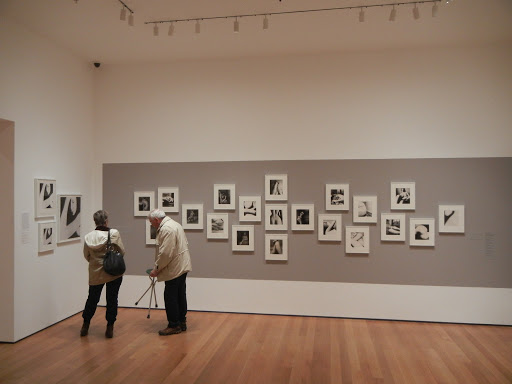 One topic that is touched on in this show and expanded on with more force in the accompanying catalog is a discussion of Brandt’s printing techniques. As the years pass in this exhibit (and as you walk through the sections of the show), Brandt’s palette very visibly moves from an enveloping thick blackness to a grainier, more exaggerated high contrast extremity of black and white; it’s impossible to miss if you sweep your eyes across the rooms. If you look closely at Brandt’s prints, they are heavily retouched, covered in ink blots, scrapes, highlights, and scrawls that enhance the visual effect. I always used to chalk this up to Brandt being a poor or messy printer, who required all kinds of post-production modifications to make his prints even workable. I have now come to see Brandt’s tuning as something more consciously and controllingly artistic, a physical process of reinterpreting the negative again and again. Three prints of his famous nude with her elbow bent (unhelpfully entitled London, but iconic nonetheless) show how he was experimenting with size and contrast over the decades, moving between curved, nuanced depth and rough flatness. Lee Ann Daffner’s text in the catalog is truly fascinating, showing thumbnails of each additive and reductive technique, a kind of parade of obsessive hidden craftsmanship.
One topic that is touched on in this show and expanded on with more force in the accompanying catalog is a discussion of Brandt’s printing techniques. As the years pass in this exhibit (and as you walk through the sections of the show), Brandt’s palette very visibly moves from an enveloping thick blackness to a grainier, more exaggerated high contrast extremity of black and white; it’s impossible to miss if you sweep your eyes across the rooms. If you look closely at Brandt’s prints, they are heavily retouched, covered in ink blots, scrapes, highlights, and scrawls that enhance the visual effect. I always used to chalk this up to Brandt being a poor or messy printer, who required all kinds of post-production modifications to make his prints even workable. I have now come to see Brandt’s tuning as something more consciously and controllingly artistic, a physical process of reinterpreting the negative again and again. Three prints of his famous nude with her elbow bent (unhelpfully entitled London, but iconic nonetheless) show how he was experimenting with size and contrast over the decades, moving between curved, nuanced depth and rough flatness. Lee Ann Daffner’s text in the catalog is truly fascinating, showing thumbnails of each additive and reductive technique, a kind of parade of obsessive hidden craftsmanship.
 What I find exhilarating about this exhibit is that even with all the obvious smartness poured in here, and all the new things to be learned, Brandt emerges with his elusiveness intact. I still walk away unsure of where exactly he stands. For me, this is part of his enduring draw; his photographs are mercurial, and volatile, and ultimately unknowable, even when I feel like I’ve found my way in.
What I find exhilarating about this exhibit is that even with all the obvious smartness poured in here, and all the new things to be learned, Brandt emerges with his elusiveness intact. I still walk away unsure of where exactly he stands. For me, this is part of his enduring draw; his photographs are mercurial, and volatile, and ultimately unknowable, even when I feel like I’ve found my way in.
Collector’s POV: Given this is a museum show, there are of course no posted prices. Brandt’s work is readily available in the secondary markets, with dozens of prints on offer each year. Recent prices have ranged from $2000 for lesser known works and later prints to more than $90000 for vintage prints of his most iconic images. The Brandt estate is represented in New York by Edwynn Houk Gallery (here).

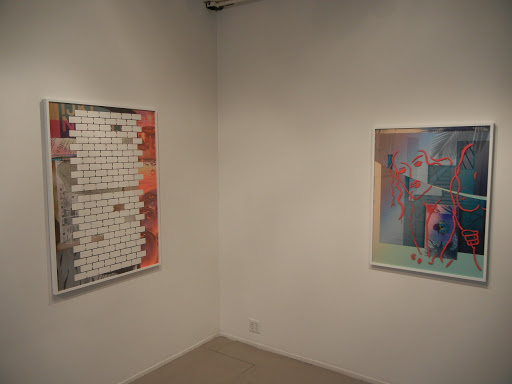 JTF (just the facts): A total of 7 black and white and color works (including 1 triptych), framed in white and unmatted, and hung against white walls in the main gallery space. All of the works are archival pigment prints, made in 2013. Sizes for individual prints/panels range from 32×24 to 47×34 (or reverse), and all of the works are available in editions of 5. While the majority of the photographs on view are displayed in a standard manner, one work includes an oil paint drawing on the protective outer glass and another is covered in dark brown plexiglas. (Installation shots at right.)
JTF (just the facts): A total of 7 black and white and color works (including 1 triptych), framed in white and unmatted, and hung against white walls in the main gallery space. All of the works are archival pigment prints, made in 2013. Sizes for individual prints/panels range from 32×24 to 47×34 (or reverse), and all of the works are available in editions of 5. While the majority of the photographs on view are displayed in a standard manner, one work includes an oil paint drawing on the protective outer glass and another is covered in dark brown plexiglas. (Installation shots at right.)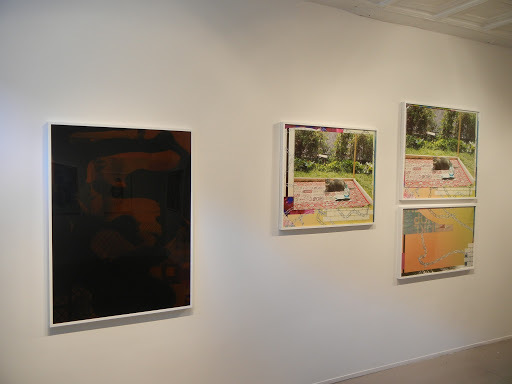 Abeles has said that her works consider how we view imagery on computer screens, and it’s clear that her crowded, overlapped compositions imply a sense of interrupt-driven, tangent-following distraction. Her juxtapositions swirl and recur, flattened into one continuous plane of imagery that can be peeled back layer by layer. New elements in these works include a while subway tile-like graphic overlay, stenciled letters, transparent bubbles, strands of looping silver chain, gradient color blocks, and the ultimate cliché of the Internet, the kitty picture. These images and effects stutter and repeat in mash-ups that seem like snapshots in fluid, screen-mediated, image-saturated time.
Abeles has said that her works consider how we view imagery on computer screens, and it’s clear that her crowded, overlapped compositions imply a sense of interrupt-driven, tangent-following distraction. Her juxtapositions swirl and recur, flattened into one continuous plane of imagery that can be peeled back layer by layer. New elements in these works include a while subway tile-like graphic overlay, stenciled letters, transparent bubbles, strands of looping silver chain, gradient color blocks, and the ultimate cliché of the Internet, the kitty picture. These images and effects stutter and repeat in mash-ups that seem like snapshots in fluid, screen-mediated, image-saturated time. In a few cases, I found the ideas Abeles is wrestling with more compelling than their end results, but it’s clear that she’s exploring some new territory here, trying to come to terms with the compressing weight of imagery around us and how is it affecting the ways in which we process those inputs. Her work feels something like an opportunistic Internet organism, ever adapting, mutating and recombining.
In a few cases, I found the ideas Abeles is wrestling with more compelling than their end results, but it’s clear that she’s exploring some new territory here, trying to come to terms with the compressing weight of imagery around us and how is it affecting the ways in which we process those inputs. Her work feels something like an opportunistic Internet organism, ever adapting, mutating and recombining.